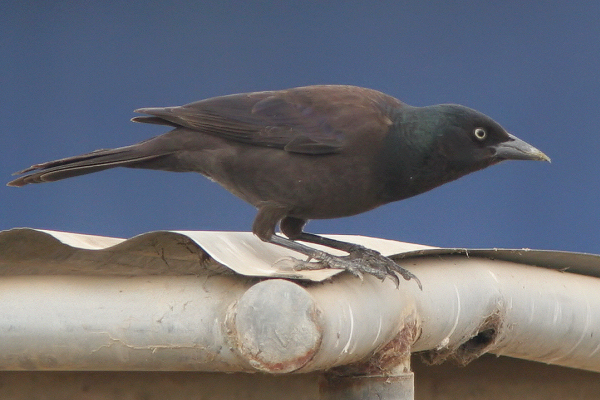
Location: Tijuana River Valley OSP, Imperial Beach, CA
Date: 2005-12-29
Lens: Canon 300mm IS F4 + 1.4x II Converter

 Common Grackle
Quiscalus quiscula
Common Grackle
Quiscalus quiscula
 Description
DescriptionThe Common Grackle is an opportunistic feeder and will feed on a wide variety of animal and vegetable food, including insects, invertebrates, fish, mice, small birds, and agricultural grain and seeds. The clearing of eastern forests for agriculture has benefited the Common Grackle, which feeds on waste grain and seeds. The Common Grackle is spreading west with the planting of ornamental trees.
General: 11 to 13.5 inches in length. Sexes similar, but female is duller and slightly smaller. Lighting effects may make the entire bird appear black.
Bronzed Grackle: Black head with blue-green iridescence. Sharply defined bronze back. Long, black tail with purplish iridescence. Tail displays a longitudinal ridge or keel when in flight. Pale yellow eyes. Long, black, pointed bill. Dark legs. Found west of the Appalachian Mountains and in New England.
Purple Grackle: Black head, back, and sides with purple iridescence. May have iridescent barring on the back. Long, black tail with possible blue-green iridescence. Tail displays a longitudinal ridge or keel when in flight. Pale yellow eyes. Dark legs. Found from central Louisiana and Alabama north to southern New York and Connecticut.
Open areas with scattered trees, including open woodland, lawns, boreal forest, marshes, agricultural areas, urban residential areas, and parks.
 Nesting
Nesting1-7 light bluish-gray eggs with dark markings and spots, usually concentrated at the large end. The eggs have a 13-14 day incubation period. Fledging occurs in 16-20 days. The nest is a bulky, open cup made of woody stems, leaves, grass, string, bark, and other materials; and lined with mud and fine grasses or hair. The nest is built in a small tree, typically a conifer. The Common Grackle nests in dense colonies, with as many as 10 to 100 pairs of birds. During courtship, it jerks its body, lowers its wing, tail, and head, and squeals.